Cotoneaster spp.
Don’t you love showy plants that provide multiple seasons of interest?
Cotoneaster shrubs are hardworking and impressive ornamentals that provide attractive displays in three to four seasons.
Spring brings deep green foliage and small, pink, red, or white blossoms that form masses of green berries in summer.
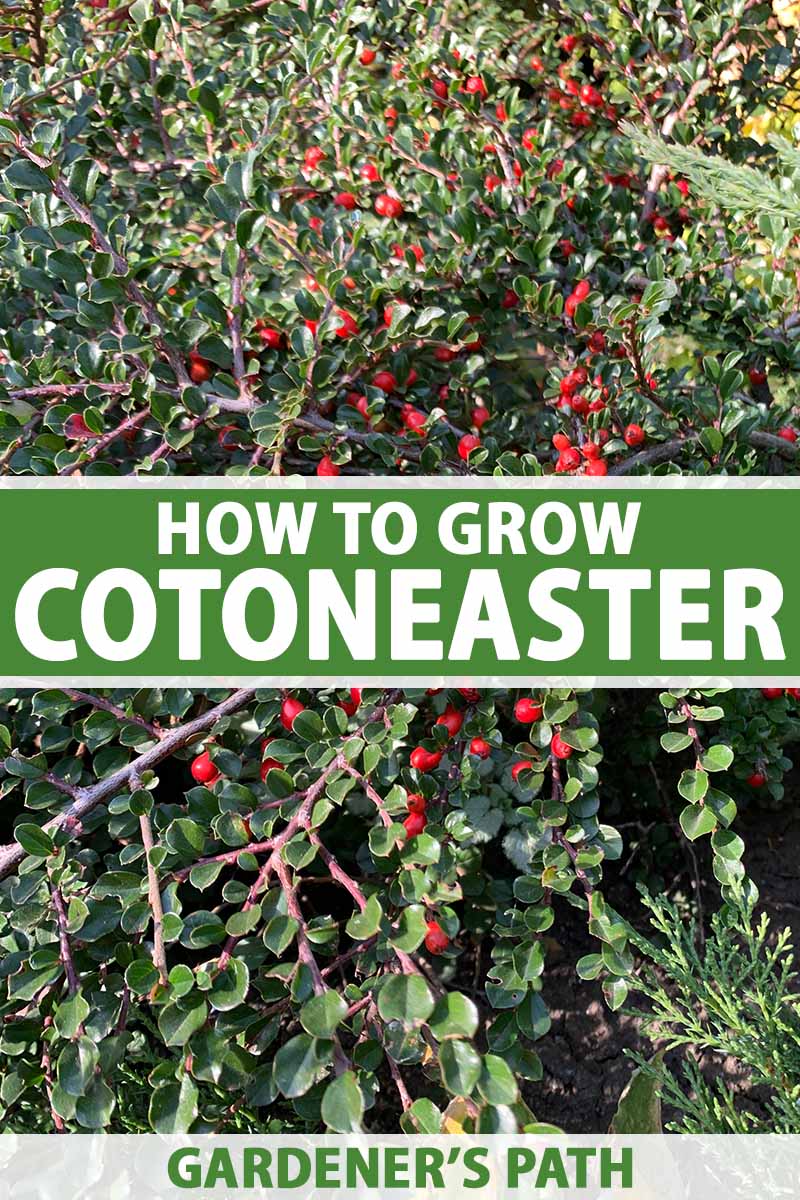
We link to vendors to help you find relevant products. If you buy from one of our links, we may earn a commission.
In fall, the small berries (known as pomes) ripen into brilliant shades of red, from bright cranberry to dark black cherry.
And many species, both deciduous and evergreen, display luminous fall colors in shades of crimson, maroon, orange, purple, scarlet, and yellow.
In most cases, the bright pomes remain on the shrub through autumn and into winter, attracting a variety of hungry songbirds.
Tough and hardy, these robust shrubs are easy to cultivate in the garden and versatile to the max. With different growth habits, including sprawling or upright, there’s one, or several, suitable for almost any location.
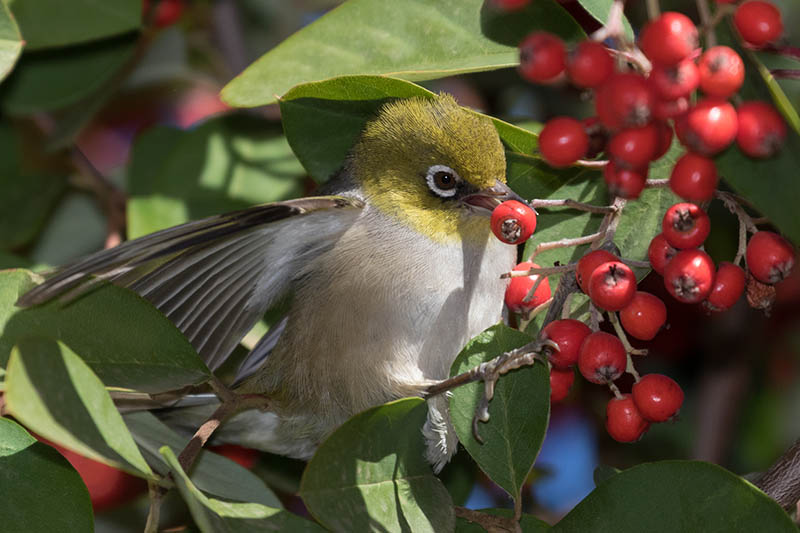
They can be grown as bonsai, in borders or containers, used as ground covers or hedges, espaliered to fences, foundations, and walls, or standardized into specimens. Plus, they make an excellent choice to control ground erosion on banks and slopes.
And all types produce those gorgeous berries in the fall when gardens need a boost of color the most!
So, if you like your shrubs tough and resilient, but pretty and interesting, sit back and read all about how to grow and care for cotoneaster.
What You’ll Learn
What Is Cotoneaster?
Cotoneaster is a genus in the Rosaceae (rose) family native to temperate regions of Eurasia and north Africa.
The name comes from the Latin compound word of cotoneum, which means quince, and aster (resembling), which refers to their similarity to flowering quinces.
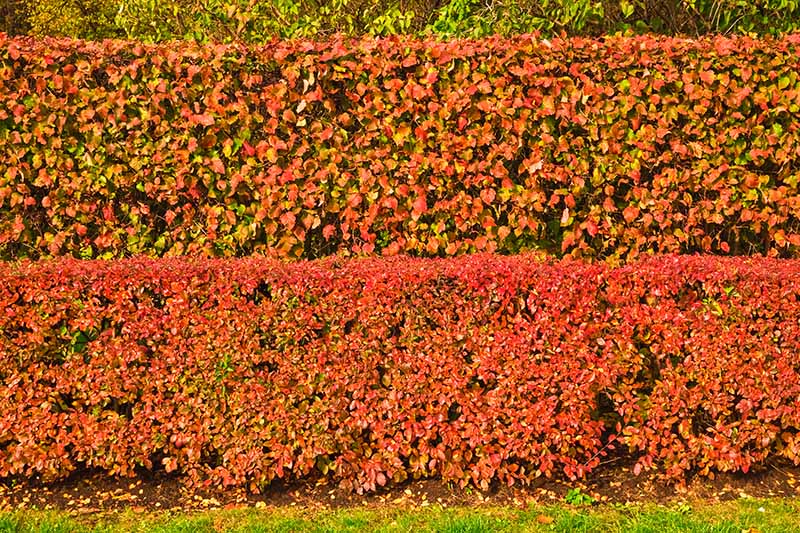
These perennial shrubs are related to hawthorns and rowans, and bear a close resemblance to the firethorn (Pyracantha) – but without the thorns.
The shrubs have a unique, dimorphic growth pattern, which means they produce long branches that provide structure to the plant and short shoots that bear the flowers and berries.
Smooth-edged leaves are arranged alternately, and can be long and ovate or small and round, and there are both deciduous and evergreen species.
Most deciduous types are cold hardy while the evergreens are better suited to cultivation in warmer regions, and both types provide striking fall colors.
Small flowers of cream, pink, red, or white appear in late spring and early summer, either singly or in large corymbs of up to 100 blooms.
Flowers often appear in the “June gap” – the time after spring flowers have finished blooming and before summer ones begin, making them highly popular with bees, butterflies, and other pollinators.
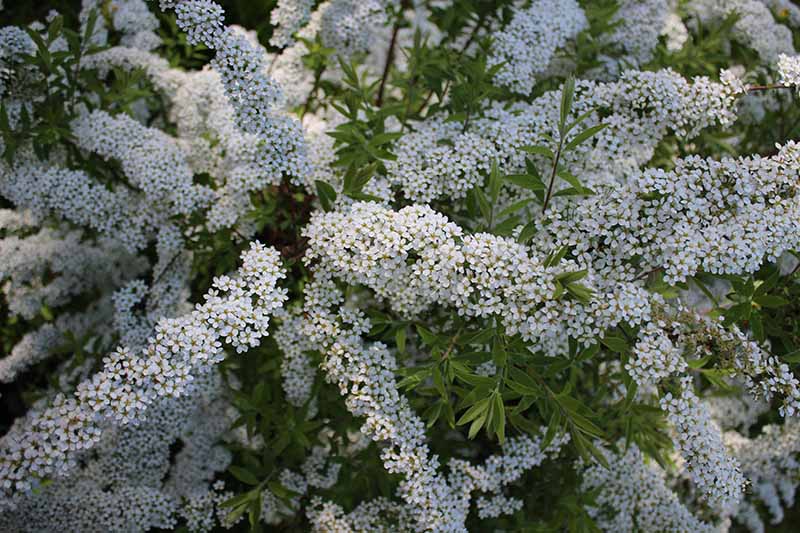
The small inedible fruits, about a quarter of an inch in diameter, contain two to five seeds and are classified as pomes, ripening to vibrant shades of bright red, orange, pink, and deep burgundy. In the case of many species, the fruit remains on the branch until the following year.
A Note of Caution: The berries are toxic to humans and animals when ingested, so keep pets and children away from them.
There are approximately 260 different Cotoneaster species, and numerous hybrid varieties.
The different species vary in size but have many similarities. All have a robust spread that’s typically three times greater than their height.
Plants are quite hardy and take in their stride a variety of harsh conditions including drought, pH fluctuations, poor soil, salt spray, and strong winter winds.
Most species are suitable for cultivation in USDA Hardiness Zones 4-8 – and there’s even a species, C. lucidus, that shrugs off the cold temperatures of Zone 3!
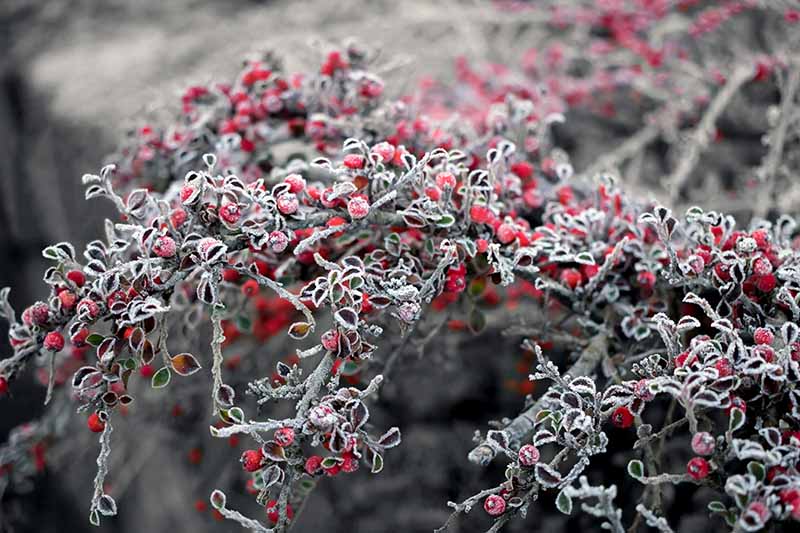
The prostrate types, with a low growing habit, work best as woody groundcovers and feature branches that arch and dip. Where the stems touch the ground, branches will take root and form dense colonies.
Upright types have the same arching and cascading growth patterns but can be trained into hedges, screens, or standardized specimens.
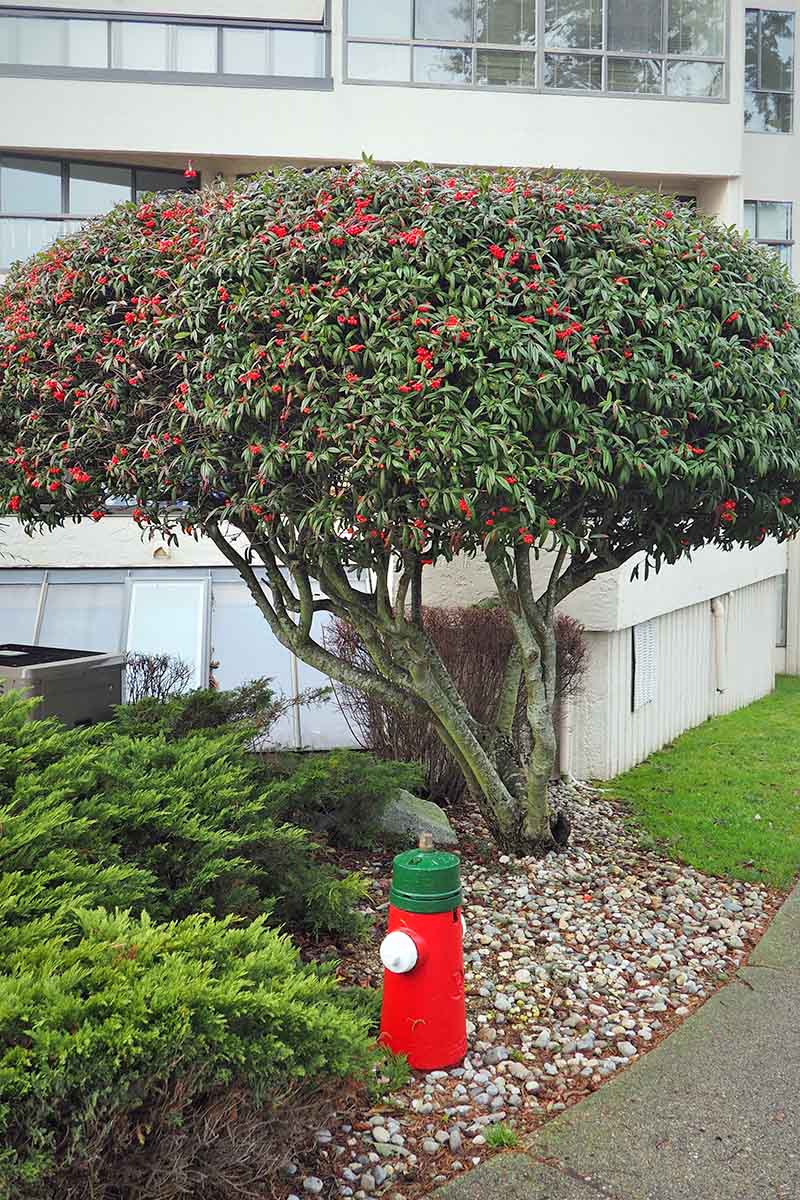
Plants can grow in full to partial shade, but will develop more branches, flowers, and berries in a full sun location. And a full sun location also develops the most vivid fall colors.
Some species have escaped garden cultivation and are considered invasive in certain coastal areas in North America such as British Columbia, California, the Great Lakes states, and the Pacific Northwest, as well as in parts of Australia, New Zealand, and western Europe.
Propagation
Cotoneaster multiplies quite easily and can be propagated by stem cuttings or from seed.
However, it can take up to 18 months for seeds to germinate. This makes cuttings the preferred method of propagation as they yield strong stock and quick results.
Alternatively, you can buy container or bare root plants for transplanting from garden centers and nurseries.
From Seed
Seeds can be collected from ripe fruit in autumn. But for germination, they require both scarification and cold stratification.
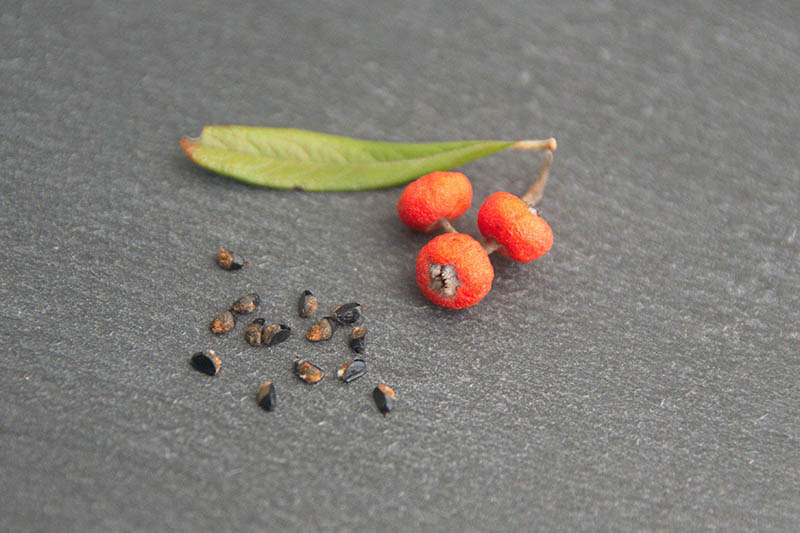
The easiest way to scar the seeds is to mix a few berries with a quarter of a cup of landscape sand then grind the mix together in a small bowl or container, mashing the fruit and scarifying the seeds at the same time.
Sow the mix (mash, seeds, and sand) into small pots containing well-draining, gritty compost. Cover the seeds lightly, water gently then set in a cold frame or in a sheltered outdoor location for the winter. Ensure the soil stays evenly moist but not wet.
Plant out in the spring or the following fall after plants have established roots.
From Cuttings
Rooting stem cuttings is a much quicker and more reliable method of propagation.
If you are taking cuttings from evergreen plants, you need to cut semi-hardwood stems at the end of summer.
In the case of deciduous plants, select softwood stems in midsummer.
Take cuttings of approximately six inches long and trim away leaves from the lower two-thirds of the stem.
To improve rooting, lightly scrape the lower two inches with a knife – just enough to remove the outermost layer of bark.
Dip the cut end in rooting hormone, shake off the excess, and place the cuttings two to three inches deep into small pots containing well-draining, gritty compost or starter soil mix.
Gently firm the cuttings in place and water lightly.
Place the containers in a cold frame or sheltered spot in the garden for the winter, and ensure the soil stays moist but not wet.
Plant out in spring after roots are established.
Transplanting
If you have bought a container plant from a nursery, or you have rooted your own cuttings, the best time to transplant is in fall, but spring works as well.
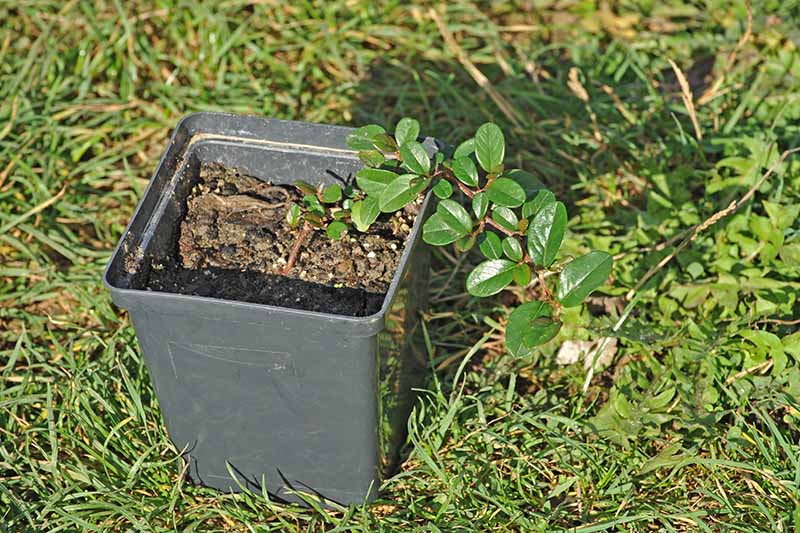
Dig a planting hole twice the width and depth of the root ball.
In the planting hole, mix in one to two shovelfuls of organic matter such as aged compost, leafmold, or well-rotted manure.
You can also add in some bone meal to promote fast growing, strong roots. One tablespoon is enough for small plants, you can apply two or three tablespoons for larger container plants.
To improve the drainage, you can mix in one to two shovelfuls of landscape sand or pea gravel as needed.
Gently remove the plant from the container, then untangle and remove any matted roots.
Set plants so the crown of the root ball is at ground level. If you are growing your shrub against a fence or wall, rotate plants so the best side faces out.
Backfill with the removed soil and firm in place. Water gently and regularly for their first growing season.
How to Grow Cotoneaster Bushes
Cotoneasters need a full to part sun location with fertile, well-draining soil. They thrive in a variety of conditions and tolerate soils with a wide-ranging pH of 5.0 to 8.0.
Before planting, consider your site for the long term – cotoneasters don’t like being transplanted.
Once established, plants are drought tolerant but need consistent watering in their first year. Aim to provide additional irrigation when the top inch of soil is dry.
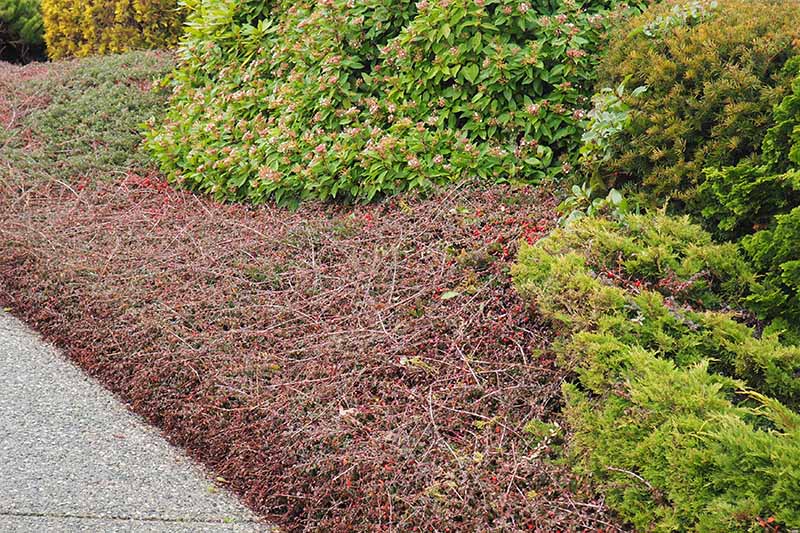
Space ground cover species three to five feet apart and hedges four to six feet apart.
When planting ground cover varieties, it’s a good idea to place a thick layer of mulch after planting for weed suppression.
Once plants start to grow and spread, weeding can be difficult due to their dense, layering branches.
You can also grow cotoneaster in containers, but you’ll need to pay attention to the mature height and width of your chosen variety, and select a pot that’s deep and wide enough to accommodate it.
Keep in mind for container-grown plants that they require more moisture than those planted in the ground and should be watered when the top inch of soil is dry, even in the case of well-established plants.
Growing Tips
Keep the following tips in mind for strong, healthy plants:
- For abundant berries and vibrant fall color, plant in a full sun location.
- Established plants are drought resistant but enjoy an occasional deep soak in prolonged dry spells.
- Prune regularly to promote dense foliage.
Pruning and Maintenance
Regular pruning helps cotoneaster to stay dense and promotes lush foliage as well as ample flowers and berries.
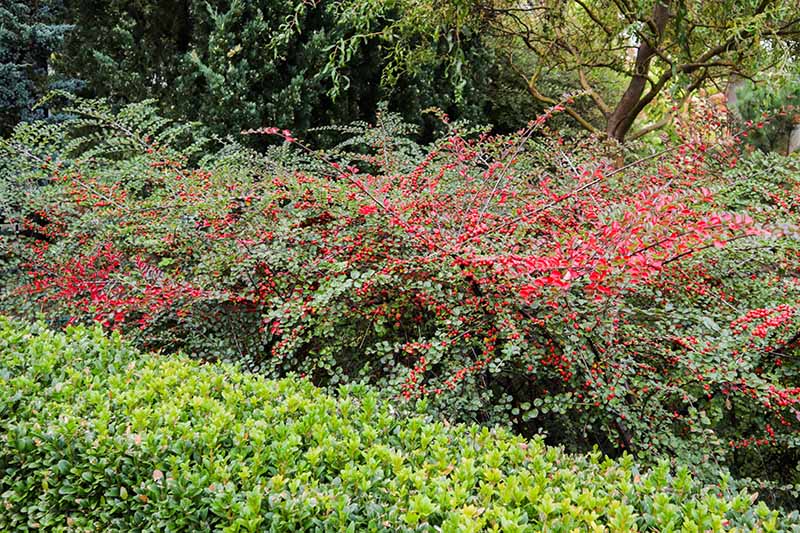
The best time to prune is in early spring before new growth appears, but you can also do so after flowering, just bear in mind that this will reduce the number of berries.
Remove any dead or diseased branches, cut stems all the way to the base – if you shorten them or cut mid-stem, the new growth tends to shoot straight up in the air.
If the plant has become too dense, you can also remove old stems from the center for better air circulation.
Light feeders, plants benefit from an annual application of fertilizer in spring. You can use a balanced formula such as 20-20-20 (NPK) or a high nitrogen lawn formula such as 10-5-5.
Cultivars to Select
Your first decision will be whether you want to plant a ground cover, an upright type, or a hedge.
Here are some of my favorite cultivars:
Coral Beauty
A compact plant with a broad spread, the evergreen ‘Coral Beauty’ (C. dammeri) has pretty white flowers and long lasting, coral pink fruit. The glossy green leaves turn a burnished, deep bronzy-red to purple in fall.
Fast growing and fine textured, plants self-root freely and form a dense colony for an attractive groundcover, erosion control, or creeping in rockeries. Plants reach mature heights of 18 to 24 inches with a spread of five to six feet, and are hardy in Zones 5-10.
Plants are available in one-gallon pots at Nature Hills Nursery.
Cranberry
Low growing with glossy green leaves, ‘Cranberry’ (C. apiculatus) puts on a sensational, cascading display of pretty pink blossoms followed by bright red berries in a distinctive herringbone pattern. Striking fall colors of gold, red, and purple add to its allure.
Branches self-layer and root readily, making it highly effective as a ground cover or informal low hedge, in rockeries, spilling over retaining walls, and for erosion control. It grows up to three feet tall with a spread of six feet and is hardy in Zones 4-7.
Plants in one-gallon containers are available at Home Depot.
Emerald Beauty
Bred for improved branching and fire blight resistance, the evergreen hybrid ‘Emerald Beauty’ (C. x suesicus) features beautiful, glossy leaves of emerald green, masses of white blooms in spring, and colorful orange berries in autumn.
The tight, mounding habit requires no pruning and makes an excellent, dense ground cover or low “step over” hedge. Plants are also suited to containers, rockeries, and for slope stabilization.
They reach heights of 18 to 24 inches and spread three to four feet. Hardy in Zones 5-9.
Plants are available in two-gallon containers from Nature Hills Nursery.
Peking
A deciduous shrub with upright, arching branches, ‘Peking’ (C. acutifolius var. lucidus) features shiny green foliage with delicate pink flowers that develop black pomes. And it puts on a sumptuous fall display in luminous shades of orange, scarlet, purple, and yellow.
The tall plants mature into a pretty rounded shape and make an excellent choice for informal hedges, a screen plant, espaliered on walls, or trimmed into a tightly sheared hedge.
It reaches a mature height of eight to 10 feet with a spread of five to six feet and is hardy in Zones 3-7.
Three- to four-feet tall bare root plants are available at Nature Hills Nursery.
Tom Thumb
A dwarf creeping variety, ‘Tom Thumb’ (C. adpressus) is deciduous to semi-evergreen with deep green, glossy leaves that turn vivid shades of crimson in fall. It rarely flowers or produces fruit, but when they do appear, the flowers are pinky white followed by small, bright red fruit.
The compact plants become very dense from self-rooting and make an attractive groundcover or can be grown as a featured specimen in containers and rockeries. Expect mature heights of 12 to 24 inches with a spread of four to six feet. Hardy in Zones 4-7.
Plants are available in one-gallon containers at Nature Hills Nursery.
Want More Options?
Then check our our guide: 21 of the Best Cotoneaster Varieties for Ground Covers, Hedges, and More.
Managing Pests and Disease
Deer and rabbits leave cotoneaster alone, and plants are not typically bothered by many pest or disease issues, but there are a few you’ll need to keep an eye out for.
Occasionally, pests like aphids and armored scale insects, such as oystershell scale, appear in summer.
Rarely fatal, aphids are soft bodied insects that suck sap from the stems and leaves and can leave an unsightly trail of honeydew.
You can control aphids by removing them with a strong blast of water from the hose, or release beneficial predatory insects such as ladybugs or lacewings into the garden.
Learn more about how to control aphids in this guide.
Scale insects look like small, oval or round plates of various colors on stems and foliage that can weaken or destroy plants.
They can be controlled by an application of neem oil in late winter or by releasing beneficial insects in summer, like ladybugs, lacewings, and predatory wasps.
A disease called fire blight, caused by the bacterium Erwinia amylovora, can sometimes be a problem, causing damage to limbs or in severe cases, the entire plant.
In early spring, watch for cankers appearing on branches, stems, and twigs that soon ooze with a light colored substance. Later in spring, branches, and flowers will blacken and shrivel.
Infected branches must be removed and destroyed. In the case of a severe infection, the entire plant will need to be removed and destroyed.
Powdery mildew is a fungal infection that can also make an appearance, although it’s not as problematic as fire blight.
It appears as a powdery white spore growth on branches, leaves, and stems, typically in conditions when temperatures are cool and humidity is high.
You can prevent outbreaks of powdery mildew by planting in full sun, in well-draining soil, and spacing plants as recommended to provide adequate air circulation, to avoid the build up of humidity.
Learn more about powdery mildew in this guide.
Best Uses for Cotoneaster Shrubs
Thanks to the highly ornamental red pomes and attractive fall foliage, cotoneaster is a popular choice for groundcovers, hedges, rockeries, and for underplanting shrubscapes.
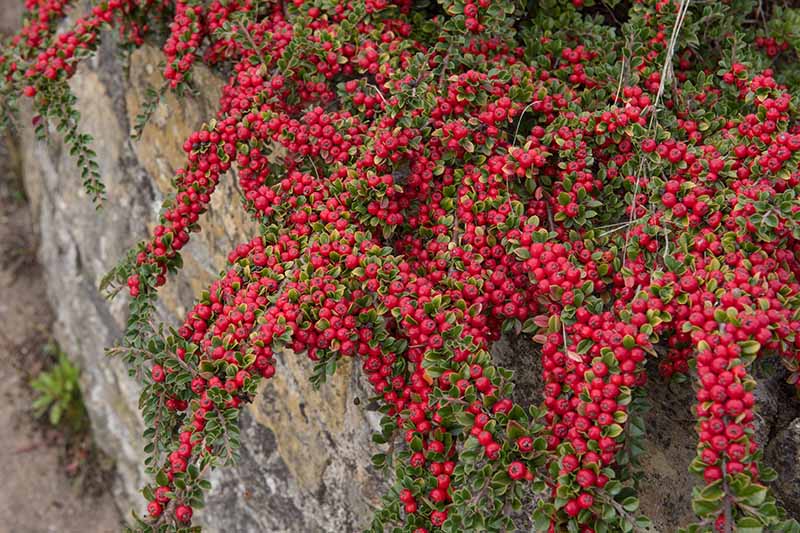
Plants can be left freeform for a loose, natural look or sharply clipped into tight hedges for a more formal appearance.
The prostrate cultivars also make excellent slope stabilizers on banks or hills, with self-layering stems that create thick colonies.
Upright cultivars can be shaped into specimens and make a dramatic statement espaliered onto fences, trellises, and walls.

And they’re wonderful to grow as bonsai as well!
Quick Reference Growing Guide
| Plant Type: | Woody shrub | Flower/Foliage Color: | Cream, pink, red, white; green |
| Native to: | Eurasia and north Africa | Maintenance: | Low |
| Hardiness (USDA Zone): | 3-10 | Tolerance: | Drought, salt |
| Bloom Time/Season: | Spring | Soil Type: | Loose with average fertility |
| Exposure: | Full to part sun | Soil pH: | 5.0-8.0 |
| Spacing: | 2-4 feet (groundcover), 4-5 feet (hedge) | Soil Drainage: | Well-draining |
| Planting Depth: | Same as root ball | Attracts: | Bees, butterflies, hummingbirds, other insect pollinators |
| Time to Maturity: | 2-3 years | Uses: | Bees, birds, and other pollinators |
| Height: | 1-8 feet | Family: | Rosaceae |
| Spread: | 2-12 feet | Genus: | Cotoneaster |
| Water Needs: | Low (once established) | Species: | dammeri, franchetii, horizontalis, lacteus, microphyllus, simonsii |
| Common Pests: | Aphids, armored scale | Common Diseases: | Fire blight, powdery mildew |
A Host of Attractive Features
Hardy and highly versatile, I love cotoneasters for the yeoman’s work they bring to a garden or yard.
Easily cultivated and drought resistant once established, they have a host of attractive features, from deep green foliage and delicate flowers to bright berries and fantastic fall colors.
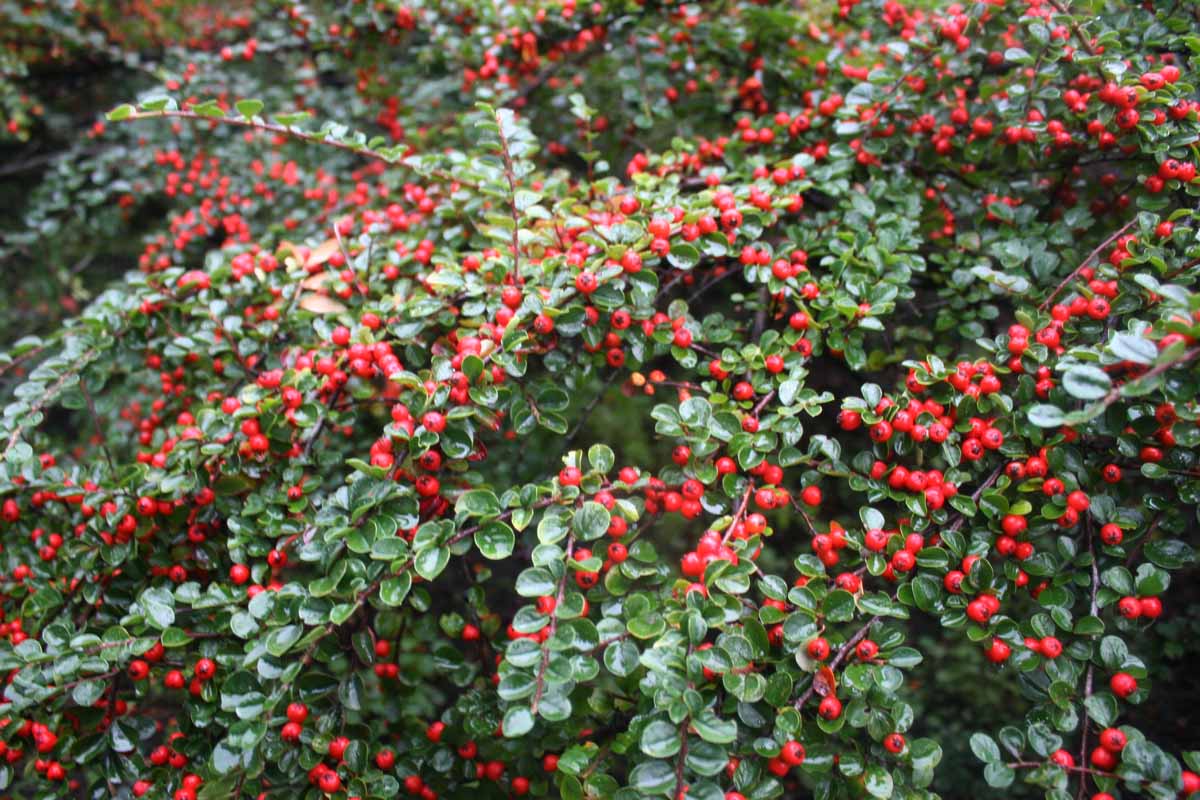
The prostrate varieties are tough little shrubs that make handsome ground covers, creeping and spilling over container sides, retaining walls, and rockeries. And the upright cultivars are superb as hedges or specimen shrubs and add vivid splashes of color when grown against fences and walls.
Whatever type you grow full sun brings out the best berries and brightest leaf colors!
Are you growing cotoneaster? Let us know in the comments section below, and feel free to share a picture!
And for more information about growing shrubs in your garden, check out these articles next:
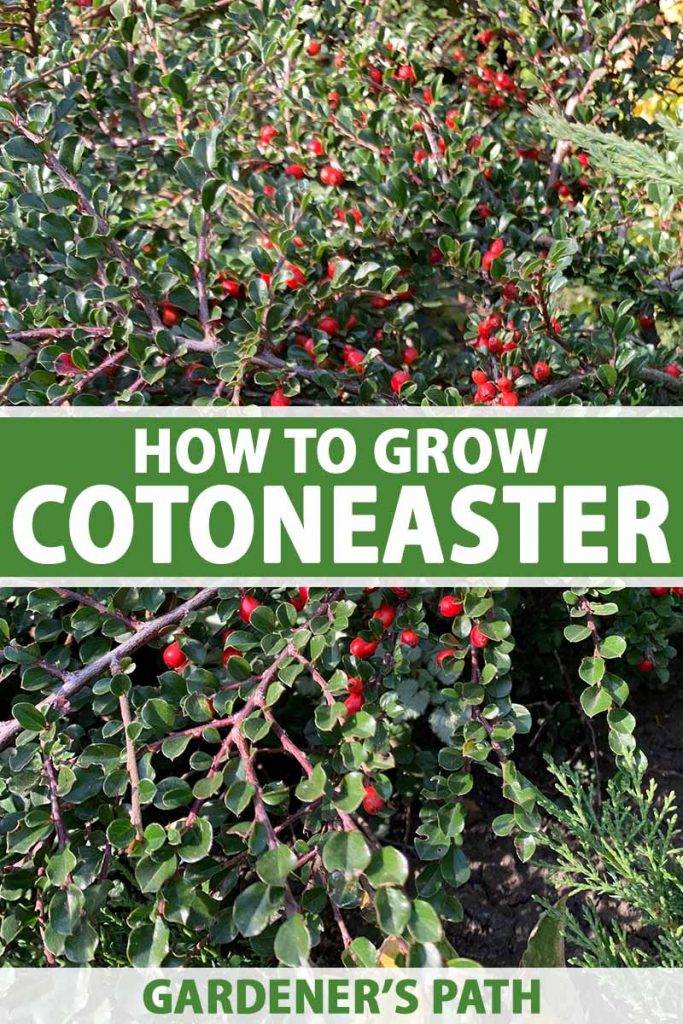
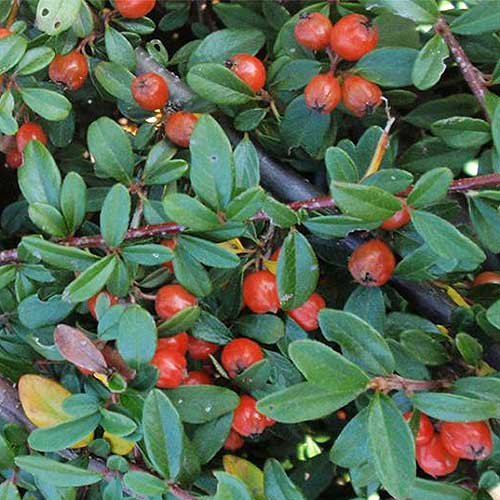
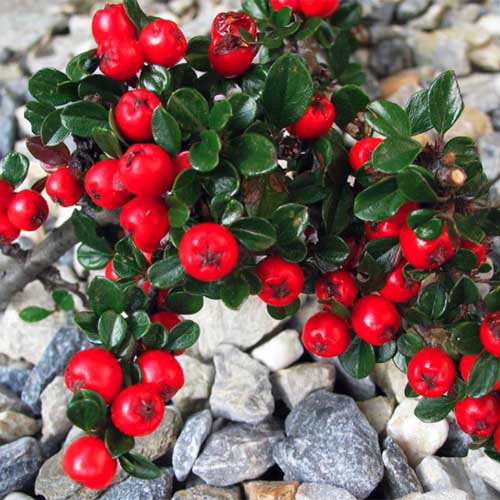
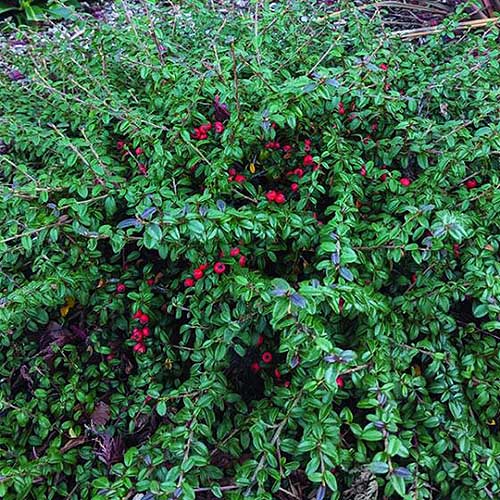
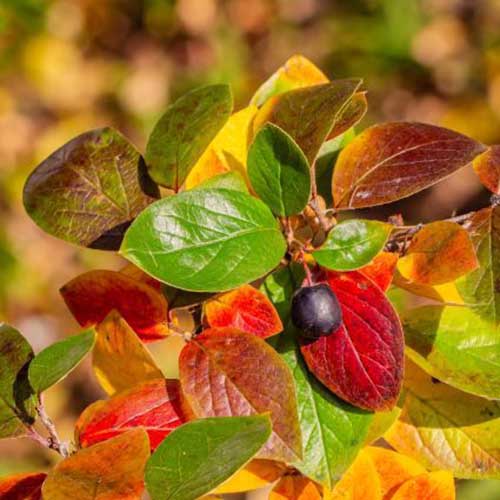
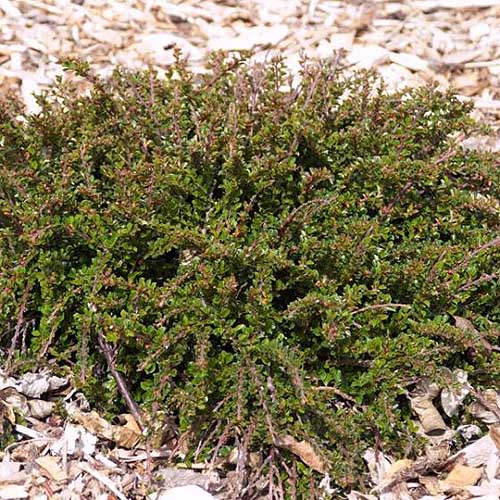
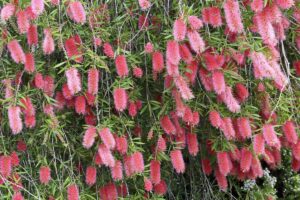
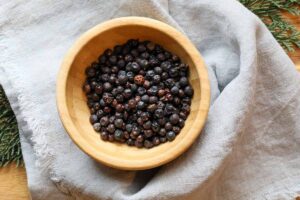
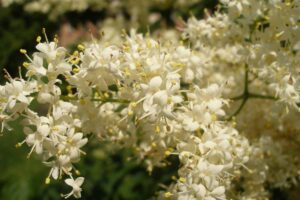
What a wonderfully comprehensive article!